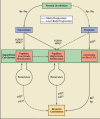Superficial bladder cancer: an update on etiology, molecular development, classification, and natural history
- PMID: 18470273
- PMCID: PMC2312342
Superficial bladder cancer: an update on etiology, molecular development, classification, and natural history
Abstract
Superficial "non-muscle-invasive" bladder tumors represent a heterogeneous group of cancers, including those that are (1) papillary in nature and limited to the mucosa, (2) high grade and flat and confined to the epithelium, and (3) invasive into the submucosa, or lamina propria. The goal of treatment is 2-fold: (1) to reduce tumor recurrence and the subsequent need for additional therapies and the morbidity associated with these treatments and (2) to prevent tumor progression and the subsequent need for more aggressive therapy. This update reviews important contemporary concepts in the etiology, molecular mechanisms, classification, and natural history of superficial bladder cancer.
Keywords: Bladder neoplasms; Genitourinary tumors; Molecular mechanisms; Non-muscle-invasive tumor; Transitional cell carcinoma.
Figures

References
-
- Jemal A, Siegel R, Ward E, et al. Cancer Statistics, 2007. CA Cancer J Clin. 2007;57:43–66. - PubMed
-
- Heney NM. Natural history of superficial bladder cancer. Prognostic features and long-term disease course. Urol Clin North Am. 1992;19:429–433. - PubMed
-
- Greene FL, Page DL, Fleming ID, et al., editors. AJCC Cancer Staging Handbook. 6th ed. New York: Springer; 2002. Urinary bladder; pp. 367–374.
-
- Zeegers MP, Kellen E, Buntinx F, van den Brandt PA. The association between smoking, beverage consumption, diet and bladder cancer: a systematic literature review. World J Urol. 2004;21:392–401. - PubMed
-
- Cohen SM, Garland EM, St John M, et al. Acrolein initiates rat urinary bladder carcinogenesis. Cancer Res. 1992;52:3577–3581. - PubMed
LinkOut - more resources
Full Text Sources
Other Literature Sources
Medical
